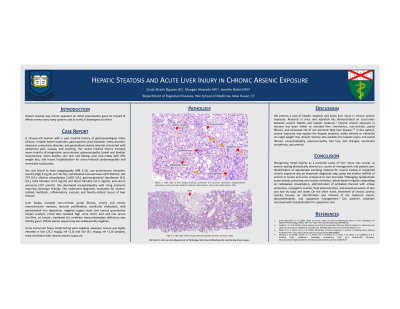Back


Poster Session C - Monday Afternoon
Category: Liver
C0612 - Hepatic Steatosis and Acute Liver Injury in Chronic Arsenic Exposure
Monday, October 24, 2022
3:00 PM – 5:00 PM ET
Location: Crown Ballroom

Has Audio
- CN
Cindy Khanh P. Nguyen, BS
Yale University School of Medicine
New Haven, CT
Presenting Author(s)
Cindy Khanh P. Nguyen, BS1, Meagan Alvarado, MD2, Jennifer Batisti, MD1
1Yale University School of Medicine, New Haven, CT; 2Yale New Haven Health, New Haven, CT
Introduction: Arsenic toxicity may not be apparent on initial presentation given its myriad of effects across many body systems and its rarity in developed countries.
Case Description/Methods: A 29-year-old woman with history of gastroesophageal reflux disease, irritable bowel syndrome, gastroparesis, post-traumatic stress disorder, obsessive-compulsive disorder, and generalized anxiety disorder presented with abdominal pain, nausea, and vomiting. Her recent medical history included 7 months of progressive sensorimotor polyneuropathy, bowel and bladder incontinence, vision decline, skin rash and flaking, poor oral intake with 25% weight loss, and recent hospitalization for stress-induced cardiomyopathy and ventricular tachycardia.
She was found to have coagulopathy, hemolytic anemia, and elevated transaminases, alkaline phosphatase, direct and indirect bilirubin, and serum ammonia. She developed encephalopathy with rising ammonia requiring scavenger therapy. She underwent diagnostic evaluation for alcohol-related, metabolic, inflammatory, and vascular causes of liver disease. Liver biopsy revealed non-cirrhotic portal fibrosis, severe and mostly macrovesicular steatosis, ductular proliferation, and canalicular cholestasis. Initial labs showed high urine orotic acid and low serum citrulline, so empiric treatment for ornithine transcarbamylase deficiency was initially given. Whole exome sequencing was negative. Urine and serum heavy metal testing was negative. However, arsenic was highly elevated in hair and nail samples, most consistent with chronic arsenic exposure.
Discussion: We present a case of hepatic steatosis and acute liver injury in chronic arsenic exposure. Recent work has associated arsenic toxicity with non-cirrhotic portal fibrosis and elevated risk of non-alcoholic fatty liver disease in humans, previously seen in mice.1 In this patient, arsenic exposure may explain the hepatic steatosis, either directly or indirectly via rapid weight loss. Arsenic toxicity also explains the hepatic injury and portal fibrosis, encephalopathy, polyneuropathy, hair loss, and skin changes. Recognizing metal toxicity as a cause of liver injury was crucial, as arsenic testing dramatically altered our course of management and patient care.
1. Frediani, J. K., et al. (2018). Arsenic exposure and risk of nonalcoholic fatty liver disease among U.S. adolescents and adults: An association modified by race/ethnicity, NHANES 2005–2014. Environmental Health, 17, 6.
Disclosures:
Cindy Khanh P. Nguyen, BS1, Meagan Alvarado, MD2, Jennifer Batisti, MD1. C0612 - Hepatic Steatosis and Acute Liver Injury in Chronic Arsenic Exposure, ACG 2022 Annual Scientific Meeting Abstracts. Charlotte, NC: American College of Gastroenterology.
1Yale University School of Medicine, New Haven, CT; 2Yale New Haven Health, New Haven, CT
Introduction: Arsenic toxicity may not be apparent on initial presentation given its myriad of effects across many body systems and its rarity in developed countries.
Case Description/Methods: A 29-year-old woman with history of gastroesophageal reflux disease, irritable bowel syndrome, gastroparesis, post-traumatic stress disorder, obsessive-compulsive disorder, and generalized anxiety disorder presented with abdominal pain, nausea, and vomiting. Her recent medical history included 7 months of progressive sensorimotor polyneuropathy, bowel and bladder incontinence, vision decline, skin rash and flaking, poor oral intake with 25% weight loss, and recent hospitalization for stress-induced cardiomyopathy and ventricular tachycardia.
She was found to have coagulopathy, hemolytic anemia, and elevated transaminases, alkaline phosphatase, direct and indirect bilirubin, and serum ammonia. She developed encephalopathy with rising ammonia requiring scavenger therapy. She underwent diagnostic evaluation for alcohol-related, metabolic, inflammatory, and vascular causes of liver disease. Liver biopsy revealed non-cirrhotic portal fibrosis, severe and mostly macrovesicular steatosis, ductular proliferation, and canalicular cholestasis. Initial labs showed high urine orotic acid and low serum citrulline, so empiric treatment for ornithine transcarbamylase deficiency was initially given. Whole exome sequencing was negative. Urine and serum heavy metal testing was negative. However, arsenic was highly elevated in hair and nail samples, most consistent with chronic arsenic exposure.
Discussion: We present a case of hepatic steatosis and acute liver injury in chronic arsenic exposure. Recent work has associated arsenic toxicity with non-cirrhotic portal fibrosis and elevated risk of non-alcoholic fatty liver disease in humans, previously seen in mice.1 In this patient, arsenic exposure may explain the hepatic steatosis, either directly or indirectly via rapid weight loss. Arsenic toxicity also explains the hepatic injury and portal fibrosis, encephalopathy, polyneuropathy, hair loss, and skin changes. Recognizing metal toxicity as a cause of liver injury was crucial, as arsenic testing dramatically altered our course of management and patient care.
1. Frediani, J. K., et al. (2018). Arsenic exposure and risk of nonalcoholic fatty liver disease among U.S. adolescents and adults: An association modified by race/ethnicity, NHANES 2005–2014. Environmental Health, 17, 6.
Disclosures:
Cindy Khanh Nguyen indicated no relevant financial relationships.
Meagan Alvarado indicated no relevant financial relationships.
Jennifer Batisti indicated no relevant financial relationships.
Cindy Khanh P. Nguyen, BS1, Meagan Alvarado, MD2, Jennifer Batisti, MD1. C0612 - Hepatic Steatosis and Acute Liver Injury in Chronic Arsenic Exposure, ACG 2022 Annual Scientific Meeting Abstracts. Charlotte, NC: American College of Gastroenterology.
